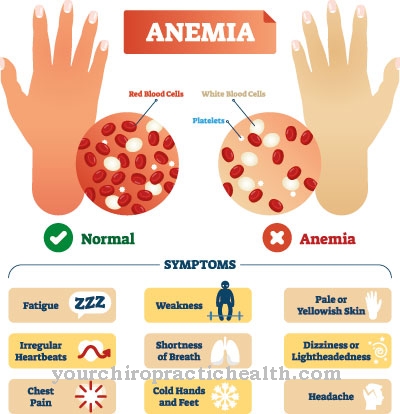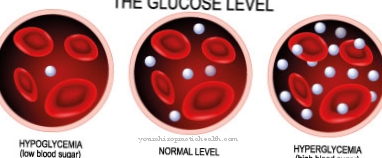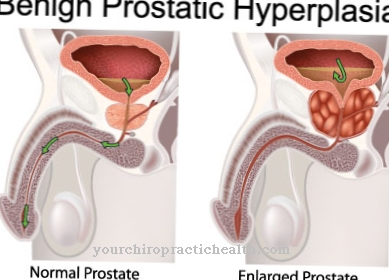As Hepatosplenomegaly medicine describes a simultaneous enlargement of the spleen and liver. This combination of symptoms can have various causes, such as infectious connections or hereditary storage diseases. Treatment of symptoms depends on the primary illness.
What is hepatosplenomegaly?

© shidlovski - stock.adobe.com
Hepatosplenomegaly is not itself a disease. Rather, it is a symptom of various diseases. Hepatosplenomegaly is always referred to when a patient has a simultaneous swelling and enlargement of the spleen and liver.
The symptom is actually two different symptoms or a combined symptom complex of an enlarged liver in the sense of a hepatomegaly and an enlarged spleen in the sense of a splenomegaly. The simultaneous presence of these symptoms is clinically relevant, as it can provide the doctor with an indication of the larger scope of the primary disease against the background of the anamnesis.
Hepatosplenomegaly is acquired in most cases and, as an acquired symptom complex, can usually be traced back to infections. The congenital form of both symptoms in babies is often caused by storage diseases or lymphatic diseases. In order to diagnose a primary disease, the age of the person affected is particularly relevant.
causes
Hepatosplenomegaly can have a variety of causes. The acquired form often goes back with viral infections such as Epstein-Barr virus or cytomegalovirus. A connection with bacterial infections is also conceivable in the acquired form. The combination of symptoms characterizes brucellosis, for example, ornithosis, parasitosis, malaria and schistosomiasis or leishmaniasis.
If the acquired form occurs without infection, tumors may be the cause. The congenital form of the two symptoms primarily indicates storage diseases such as amyloidosis or mucopolysaccharidosis. Diseases of the lymphatic system are also possible causes of congenital enlargement of the spleen and liver.
Other causal relationships can be neuroblastomas, sarcoidoses, syndromes such as Hurler's syndrome or Schnitzler's syndrome, Farber's disease and preductal aortic coarctation. That being said, the combined symptoms are often present in hepatolial diseases such as right heart failure or in liver diseases. In addition, blood disorders such as polycythemia vera have been linked to the phenomenon. Identifying the cause is critical to developing appropriate therapeutic steps.
Symptoms, ailments & signs
The symptoms of hepatosplenomegaly depend heavily on the cause in each individual case. In principle, the enlargement of the spleen and liver usually does not cause pain and can even be completely symptom-free in isolation. Often the swellings can be seen with the naked eye. Depending on the extent of the swelling, the phenomenon can compress neighboring organs of the liver and spleen. In such a case are mostly associated with functional losses of the compressed organs.
In the case of extremely massive swellings, pain also occurs. The accompanying symptoms of the enlargement of the spleen and liver are for the doctor one of the most important clues as to the actual cause of the disease. Infectious diseases, for example, are often associated with inflammation, redness and local pain or cough, hoarseness and runny nose. In addition, fever is a frequent accompanying symptom of infectious hepatosplenomegaly.
If cardiac blood congestion is responsible for the enlargement of the two organs, upper abdominal pain is the most common accompanying symptom. To list all possible accompanying symptoms of hepatosplenomegaly at this point would go beyond the scope and make little sense, since the clinical picture can be shaped by almost all symptoms depending on the cause.
Diagnosis & course
The first suspicion of hepatosplenomegaly usually overtakes the doctor through visual diagnosis and palpation. A physical examination in the form of palpation and percussion reveals the enlargement of the liver. Spleen palpation in the patient's right lateral position provides information on the enlargement of the spleen. Sonography confirms the diagnosis. In addition to determining the size, the ultrasound also helps to determine the internal and surface structure of the two organs.
A sonographic examination of the arteries and veins can identify or exclude causes such as hepatic vein congestion or portal vein dilation. As an alternative to ultrasound, a CT can be performed. For the causal diagnosis, the laboratory values are particularly relevant, especially the metabolic parameters, the immunological parameters and, if applicable, the tumor markers.
The blood test can also be used to determine or rule out infectious causes. Procedures such as liver puncture or bone marrow puncture may be required to further investigate the cause.
Complications
Since hepatosplenomegaly is a complex symptomatic disease that should be viewed as an indicator of serious health problems, the type of treatment is not aimed at hepatosplenomegaly itself, but at eliminating the cause. Therefore, the complications occurring in the course of the therapy depend on it and are accordingly of a diverse nature.
In the case of untreated hepatosplenomegaly, various complications can arise. These include internal bleeding and the appearance of blood in stool and vomit. Organs that are in direct proximity to the enlarged spleen and liver can be compressed and their function impaired.
In addition, liver insufficiency or liver failure can occur, which in turn can lead to jaundice or blood clotting disorders, as well as changes in consciousness. These range from mood swings and sleep disorders to states of confusion and even coma. Leg edema and congested neck veins can also be observed as complications.
In addition, it can lead to a disorder of fine motor skills, which manifests itself in a strong tremor of the hands. Another serious complication that can occur as a result of hepatosplenomegaly is encephalopathy, a pathological change in the entire brain. This is based on a disorder of the brain cells, which can no longer adequately fulfill their respective function; this malfunction can or does not have to be permanent.
When should you go to the doctor?
A doctor should be consulted as soon as unusual swelling in the area of the upper body is noticed. If it comes to pain, a feeling of pressure or an incomprehensible inner tension, a doctor's visit is necessary. If the symptoms start to spread or if they increase in intensity, a control visit must be carried out. If there are circulatory disorders, palpitations or circulatory problems, a medical examination is required.
Symptoms such as fever, a general feeling of illness, dizziness or reduced performance must be clarified and treated by a doctor. In the event of vomiting, loss of appetite or sleep disorders, a doctor's visit is necessary. Particular care should be taken with recurrent blood in the urine or stool. A doctor should be consulted as soon as possible so that the cause can be determined. The affected person needs immediate medical help in the event of confusion, drowsiness or impaired consciousness.
It is advisable to call an emergency doctor and to ensure first aid care until he arrives. Conspicuous skin changes must also be clarified by a doctor. Discoloration of the skin, pimples, or edema are considered unusual and should be investigated. If swelling of the legs occurs, which leads to motor problems or if the person concerned suffers from fatigue or apathy for several days, a doctor should be consulted.
Doctors & therapists in your area
Treatment & Therapy
Hepatosplenomegaly is not treated symptomatically. All treatment measures aim to eliminate the cause and thus correspond to causal therapy. The treatment depends so much on the actual trigger of the organ enlargement. If infections have caused the enlargement, the administration of antibiotics, for example, is an important step in therapy.
Drug therapy can also be used for cardiac causes such as backflow from the heart. Under certain circumstances, however, surgical treatments may also be necessary as part of such causes, for example heart valve replacement or therapeutic steps such as stenting. In the case of storage diseases and hereditary congenital syndromes, causal therapy is not possible.
In this case, the cause of the organ enlargement cannot be eliminated. Depending on the clinical picture, such diseases are treated symptomatically. If the hepatosplenomegaly is based on a tumor, excision of the tumor is the focus of therapy. Depending on the type of growth, further treatments such as radiation therapy may be carried out afterwards.
Outlook & forecast
The prognosis of hepatosplenomegaly always depends on the underlying disease. The combined enlargement of the liver and spleen is just a symptom that indicates another disease. If the underlying disease is successfully treated, the hepatosplenomegaly will also go away.
The causes are varied. These can be viral infections, bacterial infections, parasitoses, tumors, storage diseases, diseases of the lymphatic system and many other causative diseases. The prognosis of hepatosplenomegaly cannot be made separately from the prognosis of the individual underlying disease.
The prognosis for certain infectious diseases is very good. This affects, among other things, Pfeiffer's glandular fever (Epstein-Barr virus). However, severe infections and parasitoses such as brucellosis, ornithosis, malaria, leishmaniasis or schistosomiasis also often play a role.
The prognosis of the individual diseases is different. The prognosis for tumors and diseases of the lymphatic system is even worse, although a differentiation must be made here too. The storage diseases are among other things incurable and often lead to permanent hepatosplenomegaly.
Many diseases are also genetic. Congenital causes of hepatosplenomegaly are also preductal and postductal aortic coarctation. This form of hepatosplenomegaly is very dangerous. The mortality is around 90 percent if there is no therapy. However, both forms of stenosis can be successfully treated by surgery.
prevention
Hepatosplenomegaly can have so many causes that it is not possible to list all preventive measures at this point. The causes with a genetic basis cannot be prevented. Some of the infectious causes can be prevented with vaccinations. Backlogs or cardiac conditions can be prevented to a moderate extent through a healthy diet, sport and antihypertensive measures.
Aftercare
In most cases of hepatosplenomegaly, the person affected has no special or direct measures and options for follow-up care. First and foremost, a quick and, above all, an early diagnosis is important so that there is no further worsening of the symptoms or other complications. For this reason, the patient should consult a doctor at the first symptoms and signs of hepatosplenomegaly in order to prevent further complications or symptoms.
The treatment of hepatosplenomegaly requires a large number of regular visits to a doctor. The internal organs must be checked regularly in order to quickly identify the underlying disease. The disease itself is treated with the help of medication. The person affected should ensure that they are taken regularly and that the dosage is correct in order to properly alleviate the symptoms.
If antibiotics are used, it is advisable not to consume alcohol in order not to reduce the effectiveness of the antibiotics. In many cases, patients with this condition need the support and help of friends and family. This can also prevent psychological upsets or depression.
You can do that yourself
Medical treatment for hepatosplenomegaly focuses on correcting the cause. The patient can take some steps to alleviate each symptom and discomfort. In addition to medically prescribed drugs, gentle preparations such as St. John's wort capsules or valerian tea help against typical sleep disorders.
Mood swings can also be relieved using natural sedatives. Exercise and an overall healthy and balanced lifestyle also help to ensure that irritation, tiredness and other typical complaints quickly subside.
Should states of confusion arise, one must act cautiously in everyday life in order to avoid accidents. Other complaints, such as blood clotting disorders or changes in consciousness, require medical treatment. The patient should inform the doctor of any symptoms and go to hospital if the symptoms increase.
The simultaneous enlargement of the spleen and liver is not life-threatening, but the symptoms represent a considerable burden for the patient. Psychological support is therefore sensible and necessary. Talking to other sufferers, for example in internet forums or in a self-help group, makes it easier to deal with the disease and shows new ways of dealing with it.

.jpg)


.jpg)








.jpg)

.jpg)
.jpg)











.jpg)